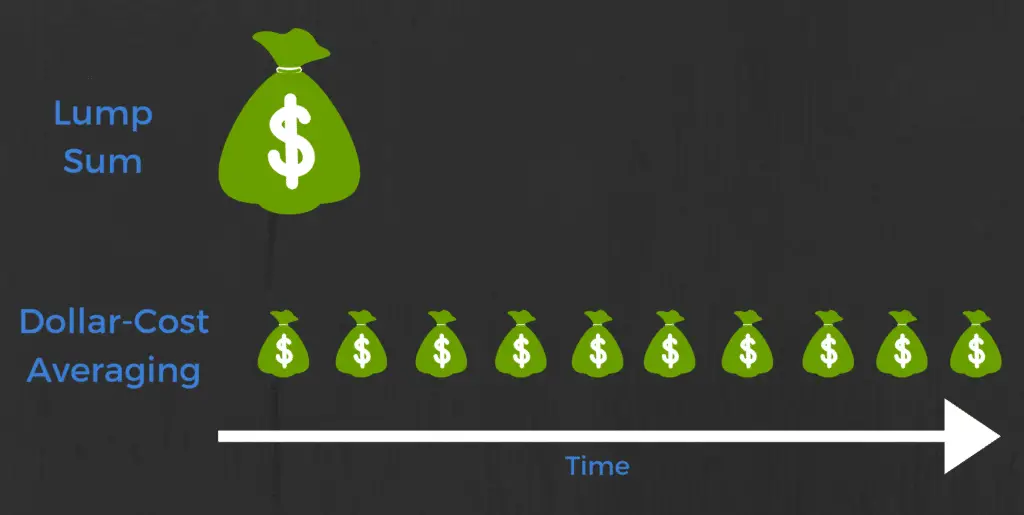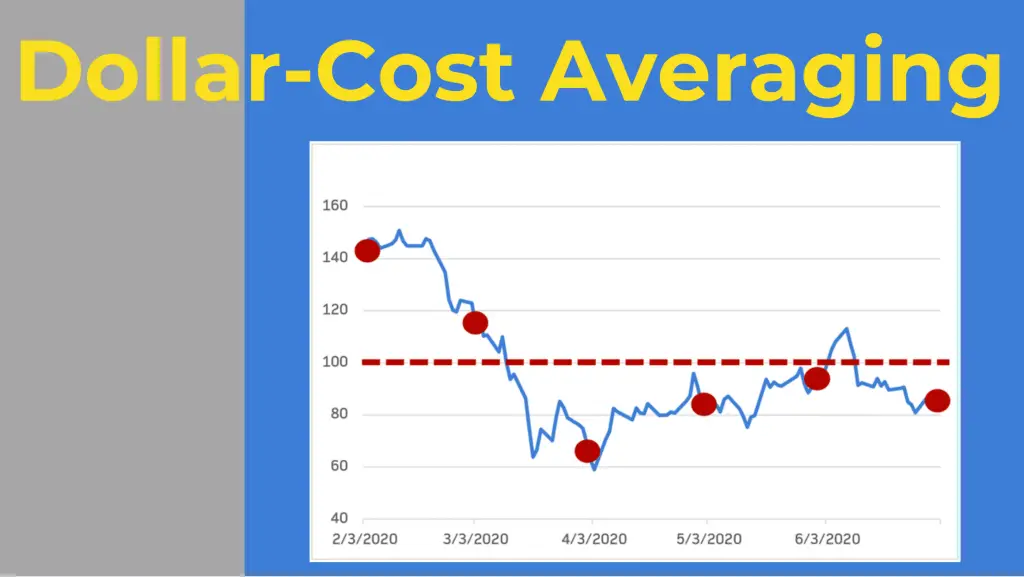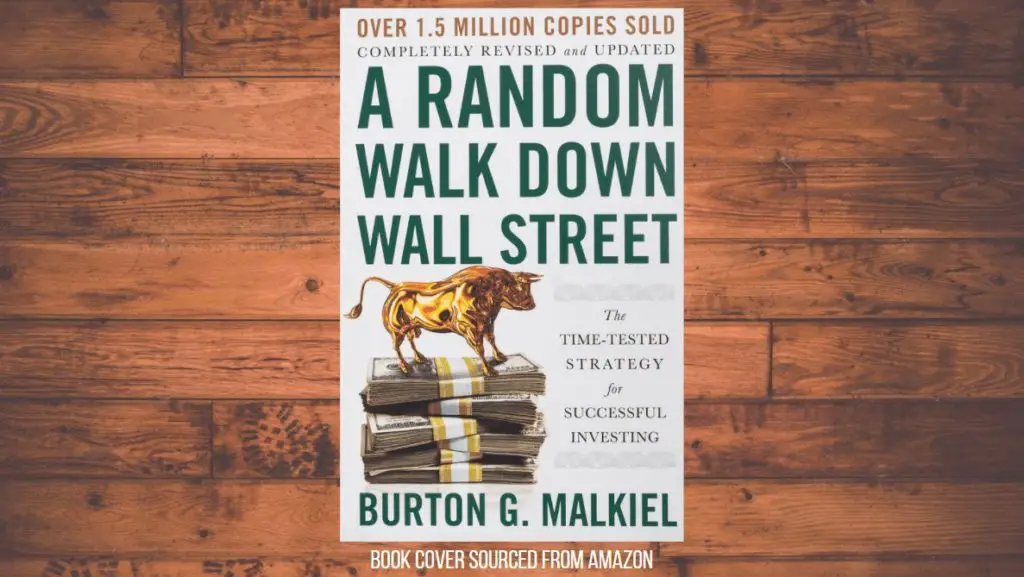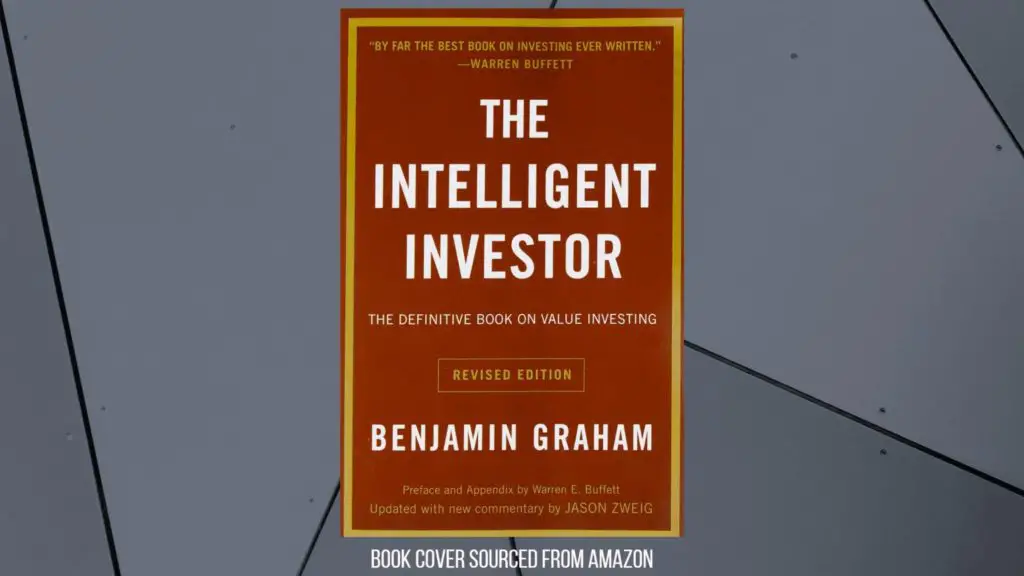This post may contain affiliate links, which means I’ll receive a commission if you purchase through my links, at no extra cost to you. Please read full disclosure for more information.
WHAT IS DOLLAR-COST AVERAGING?
Dollar-cost averaging is an investment strategy where an investor divides up the total amount they want to invest and places fixed dollar amounts in an investment vehicle (stocks, bonds, funds) over equally spaced intervals of time.
The strategy reduces the impact that short-term volatility can have on purchase price when an investor enters the market.
Imagine you have $10,000 to invest in stocks. One method is to invest the entire amount at one point in time. This is a “lump-sum” investment. Investing your funds all at once is great when the market is at a low and you buy in at the bottom.
On the other hand, this strategy backfires if you unknowingly buy in at the top of the market. When you buy in at the top of the market, the value of your investment can take a hit as the market pulls back or enters a recession.

Let’s look at a different scenario where you implement dollar-cost averaging. You still have $10,000 to invest.
This time, instead of investing all $10,000 at once, you divide that $10,000 into 10 chunks. Each chunk is $1,000 and you plan on buying into the market on the 1st of every month. Each month, you will buy $1,000 in stocks regardless of what the market conditions are.
The market may move up and down over the course of your 10 purchases. Some of those purchases will be at the peaks of the market and some will be at the lows of the market.
However, as the investor, you will not have to worry about correctly timing the market. You will avoid investing all your money at the top of the market.
DOLLAR-COST AVERAGING CALCULATION EXAMPLE
2020 was a turbulent year in the market to say the least. Let’s look at the effects of dollar-cost averaging over a 6-month period.
We have $10,000 to allocate towards one stock and we are choosing Marriott International (MAR). We will invest $1,000 on the first trading day of every month.
When you view the table below, you can see that MAR was purchased at varying prices over the 6-month period.

Although the purchase price per share ranges from $69.15 to $141.48, the average is exactly $100. The entry points are marked with the red dots on the chart of MAR’s stock price.
The first two investments in February and March have sharply declined in value due to the COVID-19 pandemic. Investments in April and May have seen a decent return thus far.
When the pandemic ends, shares of MAR should presumably increase. If business goes back to somewhat normal, the share price should well-exceed the $100 average price we entered at.
Through dollar-cost averaging, we were able to buy into MAR as its price declined and now we can participate in its recovery. Had we invested a lump-sum of $6,000 in April instead, we would have seen the value of our investment decline 50% in two months.
STEPS TO USING DOLLAR-COST AVERAGING AS AN INVESTOR

Implementing the dollar-cost averaging strategy is pretty straightforward.
1. Identify what asset or assets you want to invest in
The first step to dollar-cost averaging is knowing what assets you are going to buy.
- Are you going to buy stocks?
- Will you buy just one stock?
- Will you buy shares of a mutual fund?
Determine what assets you will purchase using the dollar-cost averaging strategy.
2. Decide how much you want to invest each period of time
Next, you will need to decide how much you want to invest in each period of time. If you have $1,000 to spare each month, you could use $500 of that to invest each month. Or you could use $300 or $800. Pick the amount that works for you and stick with it.
Another way to decide how much to invest each period is to total the amount of funds you have available to invest. Let’s say you have $10,000. You want to invest over 10 months (periods of time).
You would divide your total amount of funds by the number of periods ($10,000 / 10) to arrive at $1,000. You have now determined that you should invest $1,000 per month.
3. Decide how many periods of time you want to invest over
The third step is to decide how many periods of time you want to make investments for. You might have your eye on a stock and decide that you want to make purchases once a month for 6 months.
Dollar-cost averaging is more effective at minimizing the effects of volatility when investments are made more frequently. For example, investing once a month for a year is better than investing twice for the whole year.
4. Stay consistent and/or automate
Dollar-cost averaging can only work if you stay consistent. That requires the investor to invest the same amount each period of time and to commit to investing in regular recurring intervals.
The strategy won’t work if you invest $200 one month, $1,000 another month, and $400 the month after that. It also won’t work if you invest for 3 months straight, take 4 months off, and then hop back into monthly investments.
To help you stay consistent, you can automate investments. Work with your brokerage to set up automatic withdrawals from your checking account that can fund your investment accounts.
BENEFITS OF DOLLAR-COST AVERAGING

Reduces impact of volatility
Dollar-cost averaging can reduce the impact of volatility because it smooths out your purchase price over time when more purchases are made.
Purchasing one stock in equal amounts once per month will help prevent you from dumping all your money in before a market crash. It will also keep you purchasing when the market is at a low point.
Eliminates need to time the market correctly
Investors from beginner to advanced both contemplate when they should enter the market. Everyone has been told to “buy low and sell high.”
Equal purchases at spaced intervals of time will eliminate the need to time the market. As long as your investment amounts are consistent, you can benefit from being in “the game.”
Removes the psychological and emotional aspects out of investing
Having money in the financial markets can reveal how emotional you can get. Nothing feels worse than losing money on a poor investment. This fear of losing money can make investors indecisive and irrational when buying and selling.
Investors may contemplate what they should buy in that given moment and how much they should buy. They’ll sit on the sidelines trying to time the market and predict what the economy will be like in 18 months.
When dollar-cost averaging is implemented, it removes the psychological and emotional aspects of investing. No matter what happens in the market, the same amount is invested at the same intervals of time.
Markets will rise over time and being in the market is one of the most important things. Investors that are irrational can make decisions and take actions that make them buy or sell when they shouldn’t have.
Helps cultivate investor discipline with the schedule of investments
Using a dollar-cost averaging strategy helps investors stay disciplined and consistent for building wealth.
A great example of this is through a 401(k) account. Contributing to accounts like a 401(k), Roth 401(k), or IRA is a form of dollar-cost averaging. Each month, contributions are made to the accounts and those funds are distributed to the chosen investments.
The great part about a 401(k) is that you elect for contributions to be automatically deducted from your paycheck. It would be much harder to stay consistent if you tried to contribute funds manually.
This automation can be applied with dollar-cost averaging. You can elect to have assets purchased with a certain amount of equity at specific periods of time.
Attainable strategy for those starting with little money
Some investors don’t want to invest because they feel that they need to accumulate a large sum of money before they start.
With dollar-cost averaging, a large sum of money isn’t necessary to begin investing. Instead of waiting until you have $10,000 of funds to invest, just commit to a goal such as investing $500 out of every paycheck.
Investing does not require you to have tens of thousands of dollars. You can start small, but just make sure you start.
Great for those who want to invest but don’t know how
Dollar-cost averaging is a great option for those who are interested in investing, but don’t necessarily know how to.
Rather than embark on the hefty task of learning all about investing, the average person can just allocate a fixed amount of money towards an mutual fund, index fund, or target date fund each month. They can invest in a passive way and still achieve diversification.
DRAWBACKS OF DOLLAR-COST AVERAGING

Trading costs/commissions from frequent purchases
Costs and commissions for purchasing shares could add up when a dollar-cost averaging strategy is used.
For example, if a broker charges $5 per trade, buying a stock once per month will result in $60 in trading costs for the year. If you invested a lump-sum, you would only have $5 in trading costs.
If you are an investor who is committed to investing healthy amounts over the course of your life, these trading costs may be negligible. Additionally, in recent years the costs of trading have been trending downwards with platforms like Robinhood offering commission-free trading.
Potential to forgo gains when markets are low
When you dollar-cost average, there is potential to forgo gains when the markets are low.
Imagine that markets have plummeted over the past 4 months. You want to buy into the markets with all the money you have, but you stick to your dollar-cost average strategy. Rather than investing $10,000 at that period of time, you only invested $2,000.
In the following 3 months, the market rallied 25% and you are angry that you didn’t invest all $10,000 at once.
This is the reality of dollar-cost averaging. You may miss out on some gains. However, you will be protected if the opposite scenario occurred. You would be even more hurt if you had invested all $10,000 at one time and the market slid even further down another 20%.
Still requires guidance on investment purchases
Implementation of this strategy does not guarantee gains or prevent losses. An investor is still taking on risk that they can lose money. Investors still need knowledge or guidance on what to purchase when they dollar-cost average.
If you are an investor, it wouldn’t be wise to purchase the same random stock each month. You’ll still have to know what to buy.
To overcome this, you can stick to investing in investment vehicles like mutual funds and index funds. Investing the same amount of money on a recurring schedule is only half the job.
Markets have proven to increase over time
Proponents of dollar-cost averaging typically compare the strategy to a lump-sum investment. They talk about the horrors of potentially investing at the top of the market and watching the sum decline as the market crashes.
This can happen, but one thing we know is that markets have proven to increase over time. If markets rise over time, then it should not matter if a lump-sum is invested all at once at the top of the market.
The value of that lump-sum may decrease, but the market will bounce back and climb higher.
SUMMARY
Dollar-cost averaging is an investment strategy to allocate fixed amounts of funding to an investment over equally spaced intervals of time.
The strategy is simple and effective and can help investors from beginner to advanced. By making frequent purchases over a period of time, the impact of volatility is reduced.
An example of dollar-cost averaging is seen in 401(k) retirement accounts. Each month, an equal amount of equity is allocated to the same investments, no matter what the conditions of the market are.
There are pros and cons to the dollar-cost averaging strategy, but I believe the pros outweigh the cons. This strategy offers a simple solution that can remove a lot of the stress, emotions, and hassle that comes with investing.



